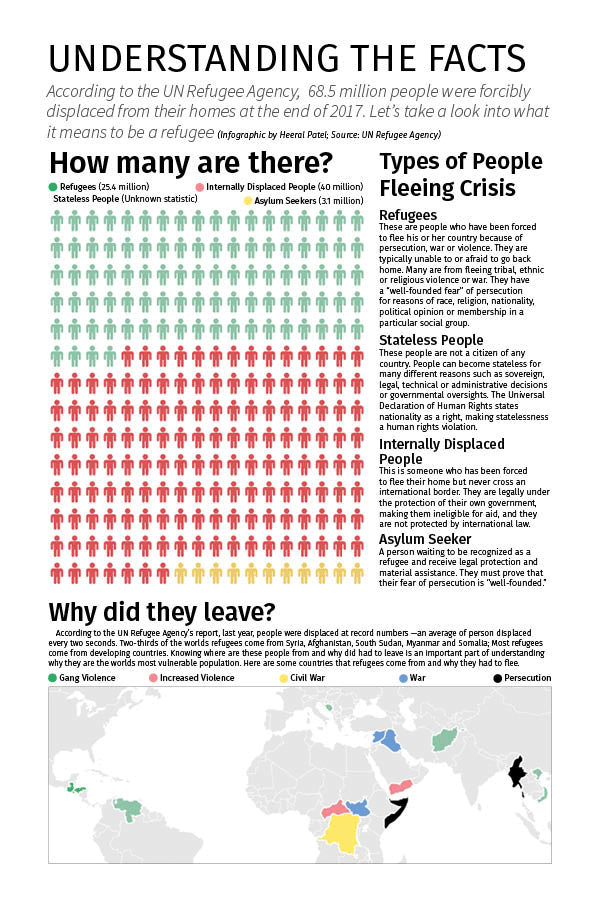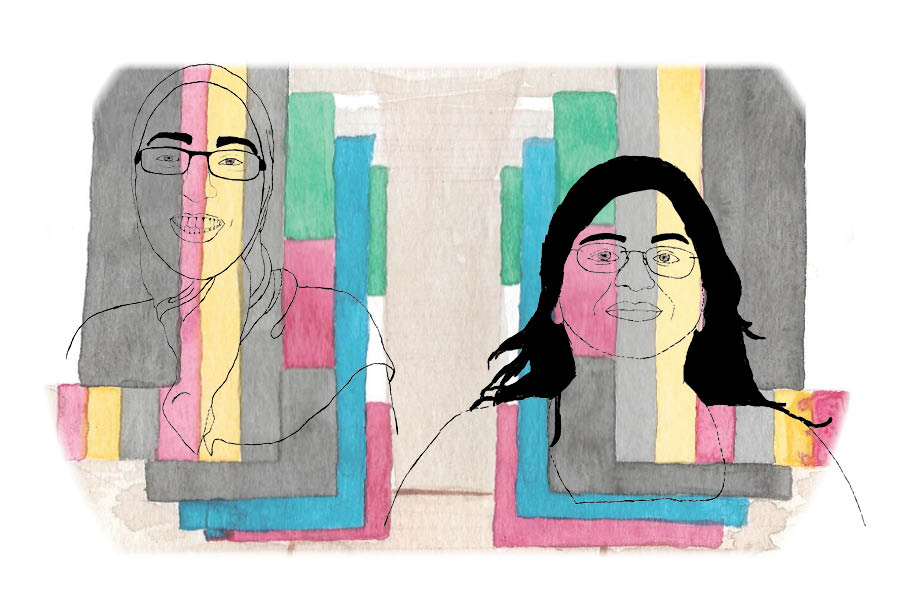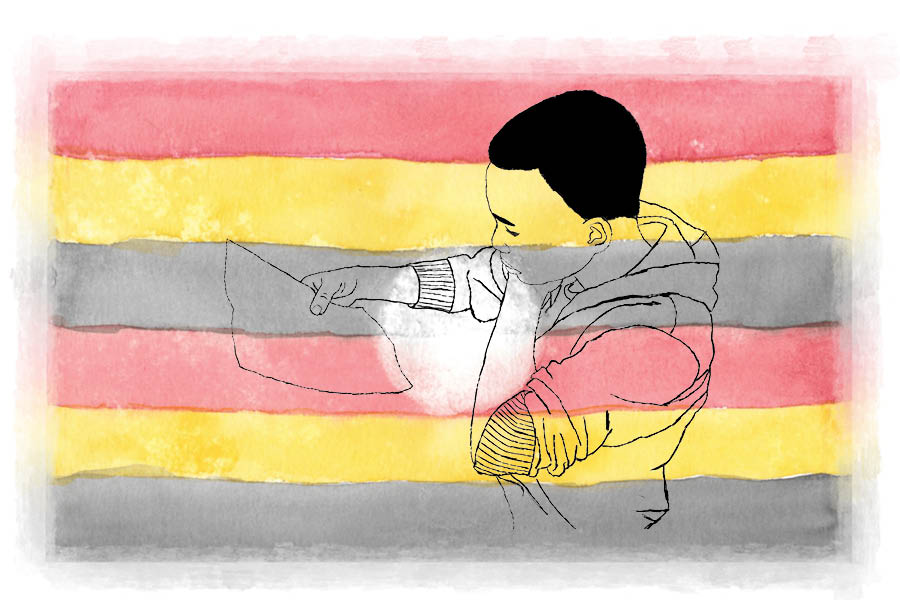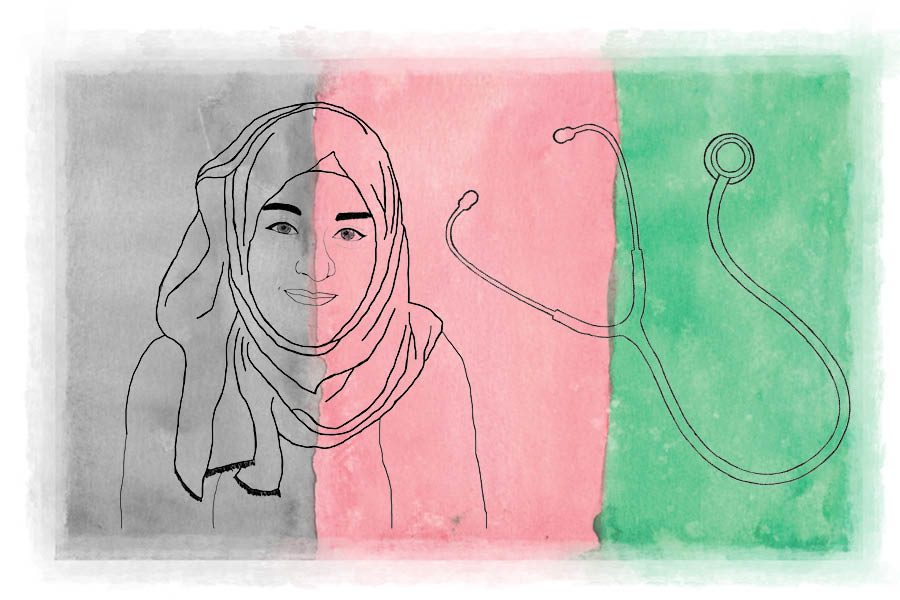Your donation will support the student journalists of Francis Howell North High School. Your contribution will allow us to purchase equipment and cover our annual website hosting costs.
The Difference Two Years Can Make
Published: November 20, 2018
Two years ago, the North Star published a story about the Nahed Chapman New American Academy, inspiring the formation of a connection between the two schools. This issue revisits the Nahed Chapman New American Academy at Roosevelt (NCNAA) showing the impact two years has on the school, its teachers and its students.

Credit to Kylah Woods and Rebekah Myers
(Designed by Kylah Woods and Rebekah Myers)
Changes in National Policy Has Caused the NCNAA Student Population to Shift Over the Last Two Years
An Afghani student sits silently in the back of the classroom. She hasn’t spoken a word. Only silence. Only the fear of getting beaten if she gives the wrong answer. She was just a young woman. She was supposed to be submissive. There was only fear.
Her brother, though, sits in a full pod in middle of the classroom, eager to speak up. He was the man, though a young man.
A Congolese student sits at the front of the classroom, excited to be learning. She had never attended school. She stays for tutoring, she asks for help, she loves school. She still struggles.
The School

Each student described is student sitting in a classroom at the NCNAA at Roosevelt High School. Though they have endured different struggles, they each still face the same challenge: learning English. Yet, at this school for newcomer Americans, teachers have only two years to teach their students English, American culture and every other subject needed to catch their students up to the average American high schooler.
Yet, these are not average students. Many of them are refugees, which are people who are forced to leave their home country and are unable or unwilling to return due to persecution, war or natural disaster. This means the schooling, lifestyle and background of each student can vary greatly, bringing lots of culture and diversity to St. Louis. A city full of refugee resettlement, meaning refugees are moved from one asylum location to St. Louis. Here, the refugees are given help to begin their new lives, getting help with housing, schooling, language services, etc.
“If you look nationally, a lot of newcomer programs are only one year, and I literally don’t have any idea how those kids survive,” ESOL teacher Keary Ritchie said. “Imagine learning [a Persian language] Farsi for one year and then being put into the mainstream high school to take physics and biology and whatever, like what? So, we do two years at Nahed. Two years is really good for us because we are a refugee resettlement city, and when you take a lot of kids that are coming from pretty hard places, and they need time to just-as Kelly [Moore] puts it- [have] a soft place to land.’”
In 2017, two years ago, however, the scene looked a bit different. To start, the NCNAA program at Roosevelt didn’t exist. There was, simply, the Nahed Chapman New American Academy. One school housing grades K-12. At the time, enrollment was exploding. Students ate lunch in the auditorium, some classes had over 50 students, enrollment had doubled to over 600 students over a year. This encouraged the NCNAA to split, with the high school division of the NCNAA moving into an empty wing of Roosevelt High School.
“There was a need to justify keeping a neighborhood school open,” Kelly Moore, Director of the NCNAA at Roosevelt, said. “So, Roosevelt being a neighborhood school, their enrollment was down, and they didn’t necessarily have the numbers to justify keeping their school open. So, moving us here helped justify keeping Roosevelt open, while also solving our space issues.”
The Shift
Since the 2016 election, many new immigration policies have been implemented and have had an effect on the school. The larger impacts to the school could be attributed to both the travel ban and the decrease in the numbers of refugees allowed to enter the US per year to 45,000 refugees —65,000 fewer refugees than before the Trump administration, according to the Refugee Processing Center. This, in part, diminished the enrollment at the NCNAA at Roosevelt, where enrollment has dropped from 140 high schoolers in 2016-17 to 79 students now.
“We’ve seen a decrease in the number of students since President Trump’s administration reduced the number of refugees allowed into the country,” ESOL teacher Bertha Martinez said. “As a consequence, I think that the number reflects in our school, so now we’re working with smaller groups, smaller numbers. Nevertheless, we are doing the same job, providing information, services, whatever the students need. I think having the smaller numbers of students is beneficial in many ways. For example, I have an opportunity to work with some students more one on one, I’m able to do group work more often, I’m able to do remedial reading with some of my fundamentals of ELA classes, so that more personalized attention. As far as the big picture [goes], though, many teenagers are lacking or they’re not getting this opportunity to come to the United States and have better opportunities as far as education or a better life overall.”
Fewer students has not been the only shift, though. People groups have also shifted. For example, the NCNAA at Roosevelt was once filled with Syrian students, but now only two remain. Now, many Afghani students take their place, in part because many Afghan families have new opportunities to obtain special visas now.
The Lasting Goal
Regardless of the shifts, the students and faculty are still doing the same thing as they always would: learning and teaching.
“I want to learn,” 15-year-old Divine said. “I want to know about different cultures because it can help me help someone from another country not from the United States. I can show them how things work.”
Although students will still continue to learn, the changes in enrollment have left the future of the program unclear. With a decreasing number of students, it becomes a question among teachers of whether the district will justify maintaining the program, which could force the refugees to become part of the mainstream ESOL classes, taking away their ‘soft place to land.’ Or, instead, there may simply be fewer class options. Or teachers will just take on more classes if staff gets relocated out of the school. There has only been speculation among the faculty, and the St. Louis Public School District declined to comment, leaving no sure answer.
“I think our big concern right now is that we have more students leaving us than that, then are coming in, so I guess we’re just sort of waiting to see what the future is going to hold,” Moore said.
That said, the school’s enrollment will always sway as immigration policies change. Therefore, when comparing enrollment to numbers prior to the large influx of students in 2015 and 2016, the enrollment is really returning to what was once normal.
“It’s always changing, you know,” Moore said. “A couple years from now, assuming that we’re still getting students in, we’ll be seeing kids from a different part of the world because there’s always different things going on depending on what’s happening. We will see different kids from different places, and, you know, that’s just something that I think that’s one of the beautiful things about this work is that it’s always different. There’s never a dull moment.”

Credit to Kylah Woods and Rebekah Myers
Teachers Rekha Shivaprasad and Fatine Bourkadi provide hope and positivity in the classroom for their students by providing a different perspective
Teachers Rekha Shivaprasad and Fatine Bourkadi Provide Hope and Positivity in the Classroom
What was once a 42-student science lab class has slowly dwindled to 23 refugee students. Now, these newcomer refugee students are able to get the one-on-one help that they need to learn the English and curriculum necessary to go into mainstream high schools after their two years at NCNAA.
“In two years, how much they are learning, whatever they are learning is their wealth for the next school,” science teacher Rekha Shivaprasad said. “I teach a lot of different skills, like graphing and each and every conversion of units, which is so hard for them. [Those skills] take time to learn. So, if I can give one on one help, it’s so helpful to them, and they can learn more.”
With recent crackdown on immigration, attendance at NCNAA has decreased within the past two years. Because of the decrease, worry among teachers about the closing of the school has started to rise.
“I am scared that they are going to close the school because of the attendance,” first-year math teacher Fatine Bourkadi said. “Just imagine that you are in a house, and you’re thrown out of your house. That’s exactly how [closing the school] will affect the students. They’re lost, they don’t know the language, they’re in a world where they don’t know anybody and they don’t know how to face that.”
Despite that fear, teachers at NCNAA are responsible for teaching the refugee children as much as they can in two years before they are sent off to mainstream high schools. This includes a variety of tasks, such as how to use a notebook and how to participate in cooperative learning. Shivaprasad finds joy in her work and helping her students.
“I see happy faces, learning children,” Shviaprasad said. “I see their improvement, their positiveness. How they interact with each other, so positively even though they are from so many different countries. How happy they are together, and even though there is still a barrier, they are still nice to each other and respect each other.”
Even though teachers like Shivaprasad and Bourkadi are able to help their students more in the classrooms, they are not able to have the biggest impact possible due to decreasing attendance.
“I don’t have the opportunity to help more students,” Bourkadi said, “It’s affecting my students, and in part, it’s affecting me too. A lot of my students have family back home that were planning to come, but unfortunately, they don’t get to come. They cannot. And that’s affecting them every day.”
While the future of NCNAA and the teachers it employs may be uncertain, the teachers are standing strong for their students.
“It’s just daily life with those kiddos that suffered every day,” Bourkadi said. “It’s a second house for them here and the thing is that we cannot do anything. Our hands are cuffed, and we cannot do anything about it. I hope I can do more and all of us hope the same, but we cannot do anything. You’re seeing it in their eyes every day. You’re seeing every hurt, every pain. But I hope that it’s going to be better. If we don’t have the night, we can’t see the stars, that’s what I tell them. And there will be stars there.”
Credit to Kylah Woods and Rebekah Myers
Learning Another Life
Afghan Refugee and NCNAA Student, Nabila, Came to America in 2016
NCNAA has paved the path for her to learn English, learn in a better environment and study to become a doctor.
Sitting toward the front of her class, Nabila types on a Chromebook, adding more information to an assignment. The classroom she’s sitting in is silent besides the echo of her fellow classmates typing on their laptops and the soft murmur of her teacher helping a student put together his Powerpoint. Long strings of colorful flags hang across the ceiling, an ample sized television hangs on the wall and a lot of labeled flashcards taped to random objects spread themselves throughout the room. This classroom is nothing like the old one she came from in Afghanistan.
Nabila moved to the U.S. when she was 12 years old, currently she is 14 years old and enrolled the NCNAA. According to Nabila, it was hard for her to adjust to a school that was so different from her old setting. At her old school in Afghanistan, the boys and girls were separated into two different schools, there was no lunch provided in the school day, there was no bus to take the students to school. Students had to walk, and, according to Nabila, the teachers wouldn’t help students, rather they would hit them and publicly shame them if the student didn’t know an answer.
“The teachers were not helpful,” Nabila said. “[Students] would come to class and the teachers would tell us to do work. They were not helping us.”
In Nabila’s new school, she receives educational help from her teachers and fellow students. Nabila says ESOL teacher Keary Ritchie has helped her to learn English in the best way she knows possible: with patience. One of the ways Ritchie helps is if a student doesn’t know a word that Ritchie is explaining, she will search for a photo to show the students to help them understand what the word means. Once she gets through schooling in America, she plans to go back to work as a doctor in Afghanistan.
“[Ritchie] helps a lot,” Nabila said. “[English] is hard to understand. We don’t speak English very well, so she helps us when we don’t understand something.”
According to Ritchie, Nabila makes a concerted effort to understand what’s in front of her while working. She helps other students in the room, starting with a girl who comes from the same area as her. She goes around to other tables of students and Ritchie considers her one of the leaders in the room.
“She goes the extra mile,” Ritchie said. “She’s completely engaged, socially responsible and she’s inquisitive. She’s an organizer and a leader. Not everybody has those skills.”
One of Nabila’s best projects she has made is a Powerpoint on the child activist Malala Yousafzai. Nabila chose Malala because she comes from the same area as she’s from. The point of the project was to test to see what knowledge the students could take and interpret. She included various photos, detailed charts and a clean layout. She looked at discrepancies with girls in the education system and wanted to get a grasp on what that problem was. One of the bigger problems she talked about was how the majority of girls in parts of Southeast Asia aren’t attending school anymore because of poverty, war and gender discrimination. The students gave an oral presentation and, according to Ritchie, Nabila was genuine and confident. She paused during her presentation while explaining something and asked students if they understood exactly what she was trying to convey.
“She poised herself well,” Ritchie said. “I liked that she was interacting with the students and she wanted the formatting to look clear. She was talking through that stuff with me in the process.”
A current project she’s working on is a presentation on a certain type of animal. She chose the Orca whale as her animal. Students find facts, specific details and comparisons about the animals and write structured sentences about them. They then will take a manila folder and color their habitat, making a small visual presentation. Ritchie’s goal is for her to write good sentences and speak clearly to the class.
“It’s a challenging task for students here to create good sentences,” Ritchie said. “It’s good practice for them to make these sentences and to work on their English.”
Nabila will graduate in December 2018. From there, she will pick a high school to go to in the St. Louis area, but before she makes any decisions, she wants to discuss it with her family. While she is still in the process of deciding, she wants to choose one that will assist her the most with achieving her dream: becoming a doctor. At NCNAA, she learns about anatomy, which helped peak her interest in becoming a doctor. Five years from now, she wants to be in college in the St. Louis area, studying and preparing for her future outside of school.
“I wanted to come to America so I could go to college,” Nabila said. “In my country, some families don’t let their girls go to college. When I finish high school, I can go to college and have the ability to be a doctor. When I grow up, I want to help people.”
Nabila wants to become a doctor in the OBGYN field because in Afghanistan there aren’t many women doctors. A lot of girls don’t go to school, so they don’t get the chance to become doctors when they get older. This results in a lot of women giving birth in unsuitable locations.
“I want to be a doctor and go back to my country,” Nabila said. “They need my help.”
Overall, Nabila is thankful for the opportunities in education she has received in the U.S. She believes she has gotten the chance to learn in more efficient ways.
“I’ll keep a lot of information I’ve learned with me for the rest of my life,” Nabila said. “The most important subject I’ll keep with me is science. Things like oceans, planets and humans.”

Credit to Kylah Woods and Rebekah Myers
A Shift in Policy
In the Past Two Years, Immigration Policy in the U.S. Has Greatly Changed
Immigration policy has changed in many aspects that have come to affect refugees and new Americans
Sherwan likes gym class.
He likes playing soccer with his friends, learning from his teachers at NCNAA and he likes living in America.
To get these simple pleasures though, he had to first flee his home in Northern Syria. After leaving his country due to war and political turmoil, Sherwan lived in Turkey, working full time starting at age 12 until he was 16. After years of waiting, Sherwan and his family, with everyone except his brother, were finally able to make the indirect flight from Germany to the U.S.
Sherwan was one of 3,024 Syrian refugees let into the United States in 2017, and he has seen first hand the dramatic changes to immigration, refugee and border control policy over the past two years.
Before leaving office, former President Barack Obama set a cap of 110,000 refugees to enter the country for the fiscal year of 2017. This would have been the highest number let in since 1995. However, within his first weeks in office, President Donald Trump cut the number in more than half, changing the annual ceiling to 45,000, which is the lowest the number has been since the Office of Refugee Resettlement’s inception in 1980. Out of this 45,000 cap, only 33,000 made it into the country, which, according to the Washington Post, made 2017 the first year in nearly four decades that the United States accepted fewer refugees than the rest of the world.
“I felt that the prior administration was more welcoming to people,” NCNAA teacher Keary Ritchie said. “I think they really tried to be sensitive to the circumstances of these people.”
Trump has also introduced a travel ban on seven countries including Syria, Iran, Libya, Somalia, Venezuela, Yemen and North Korea. There were two versions of the ban proposed before the third and final version was fully upheld by the Supreme Court.
This most recent ban placed different restrictions on each country. In some cases, like that of Venezuela, it only applies to certain government officials. But in other cases, like that of Syria, it indefinitely ends entry into the United States for refugees like Sherwan and his family. This particular policy of not welcoming the Syrian people is a large change from the previous administration two years ago. Under Obama’s presidency in 2016, the U.S. had resettled 15,479 Syrian refugees. As of October in 2018, the U.S. had only let in 31. According to Richie, this ban and its repercussions have had a damaging effect on NCNAA students and their mindset.
“I thought I would never get to the USA,” Sherwan said.
Changes have also been made to H1-B and H4 visas.
The H1-B visa allowed skilled foreign workers who had been hired by U.S. companies to live in America for three years. The changes include additional documentation requirements and new compliance rules. Businesses now must be able to provide proof that the individual hired is “more likely than not” required for the full three years of employment.
H4 visas allowed the spouses of H1-B visa holders to work in the U.S. while they are waiting for a green card, a process that can take anywhere from a few months up to 10 years. The Trump administration has proposed doing away with this Obama era rule, leaning more towards President Trump’s policy of “Buy American, Hire American.”
“In general, there is a sense of disbelief that the government would actually revoke this work authorization for high-skilled professionals who are well on their path to permanent residence,” said immigration attorney Sandra Feist in an interview with CNBC. “This will cause major personal and corporate disruption.”
Temporary Protected Status (TPS) is a protection given to individuals from countries suffering from civil unrest, natural disasters and violence who would be unable to safely return. They are able to stay in the country for a period of six to 18 months before it must be decided by the Secretary of Homeland Security if the TPS is to be renewed or not. The U.S. is providing TPS to approximately 437,000 foreign individuals from 10 countries. Since September of 2017, it has been announced that TPS is being revoked for six countries including Haiti, El Salvador, Honduras, Nepal, Sudan and Nicaragua.
“TPS will still be on the books, but will have been virtually emptied of beneficiaries at a time of the greatest number of forcibly displaced in recent history and an unprecedented number of complex crises giving rise to displacement.” Donald Kerwin, executive director of the Center for Migration Studies said in an interview with the New York Times.
In a November interview with Axios, Trump revealed that he is planning to end birthright citizenship for those born in America to noncitizens. Doing this would require a change to the 14th Amendment, which states “All persons born or naturalized in the United States and subject to the jurisdiction thereof, are citizens of the United States and of the State wherein they reside.”
Trump believes he can make this alteration with an executive order instead of going through the normal procedural steps. Currently, there are more than 4 million children living in the U.S who have citizenship but their parent does not, this executive order would take citizenship away from all of them.
“I wonder how the world looks at America now,” Ritchie said. “We have a history of welcoming refugees and immigrants and now they must be wondering ‘Is that true?.”

Credit to Kylah Woods and Rebekah Myers
Two Years, Three Schools
Isaac Finds an Atmosphere That Helps Him Understand and Learn More Effectively
As opposed to his previous schools, at NCNAA, Isaac finds an atmosphere that helps him understand the material and learn more effectively
Isaac walks on the Ugandan road to school.
His uniform can’t get dirty.
He can’t be late.
He needs to have his homework done.
Sloppy dress is reprimanded by suspension or beatings, tardiness by making the student pick up trash around the school and missing assignments by a trip to the principal’s office.
While that school is halfway across the world —and its practices are very different— Isaac’s first seven years of education had the same goal as his last two years of schooling: to teach the students.
“In Uganda, in one class [the] student [count] would get to like a hundred, and it’s hard to listen to the teacher when they put you in a seat in the back,” Isaac said. “[If] the teacher, said something and you missed it, you missed it.”
Isaac’s last months of seventh grade were spent in Georgia. He was put directly into the ESOL class and was tested for English proficiency. Within the next four days, his ESOL class was replaced by a higher level English class. Isaac recalls a fast paced environment, with tests every Friday with —what felt like— little preparation.
“It was harder to understand because every time we would move onto something new,” Isaac said. “Every Friday we would have tests, and it was kind of hard for me to understand.”
Isaac started his eighth grade year at NCNAA. He found that they taught at a slower place, allowing the students to understand the material being given to them for those same core classes, but now in a sheltered environment. Isaac finds that there are more opportunities to get help from his teachers at NCNAA. For example, students have the option to come in for help during their lunch time. This time is supplemental to time spent in class. Teachers build trust and relationships with the students, creating a family-like atmosphere —one where students can comfortably be themselves.
“[It makes the students] more open to asking questions,” Health teacher Shanta Rasheed said. ”When you’re more open and relaxed, you can then share with the teacher and tell them to tell them ‘I didn’t understand that can you say that again?’ or ‘Could you reword that?’”
Issac finds that the different teaching style works well for him. In addition to a more openness between teachers and students, Isaac feels that the students here are on the same level with their English. They’re in a place where they can help each other with school work. At NCNAA the teachers can tailor their lessons to their students’ needs.
“The teachers they all treat all of us the same way and we all learn the same way,” Isaac said. “Here, [at NCNAA] there isn’t classes that don’t speak English and classes that do. Here it’s all the same.”




